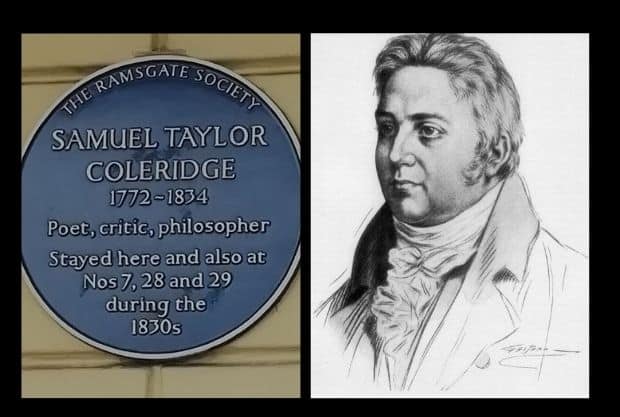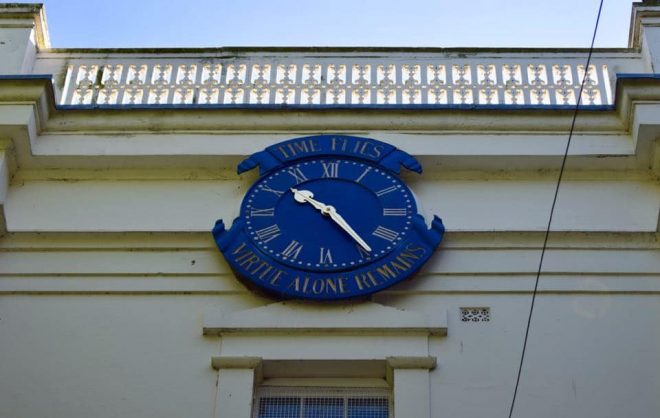
The summer of 1819 was a pretty stressful period for Samuel Taylor Coleridge. His publisher, Rest Fenner, had gone bankrupt due to financial irregularities. The poet was owed huge royalties, amounting to around £1,000 (about £89,000 today), but these, and all his copyrights with the publisher, were now in the hands of creditors.
The resulting financial worries had caused a resurgence of the poet’s anxiety and depression, something he had suffered with much of his life. Worried for his wellbeing, Coleridge’s friends, therefore, decided he needed to get away and so, in August of that year, they took him for a long holiday by the sea. The place they chose was the up-and-coming fashionable resort of Ramsgate.
Unlike John Keats, who had spent time in Margate a few years earlier, Coleridge was already an established literary figure among the well-to-do of Regency Britain. For Keats this would not happen until after his death in 1821. Coleridge was also a regular visitor to Ramsgate until his death in July 1834, whereas Keats had holidayed only twice in Margate.
Where Coleridge had lodged during his first visit is not exactly known but his surviving letters and notebooks do record what he did.
In his earliest letter from the town, Coleridge describes his walk along the cliff top to Dumpton Gap, where he took his first swim, or as he put it “a glorious tumble in the waves”. The bay was also one of the landing sites for local smugglers, namely Joss Snelling’s Callis Court Gang, something no doubt Coleridge would have heard about. Both the bay and the clandestine activities therein would later appear in his poem “The Delinquent Travellers”:
Beneath the cliffs of Dumpton Bay,
Where Ramsgate and Broadstairs between,
Rude caves and grated doors are seen:
(For Fancy in her magic might
Can turn broad day to starless night!)
When Lo! Methinks a sudden band
Of smock-clad smugglers round me stand.
Denials, oaths, in vain I try,
At once they gag me for a spy…
At Ramsgate Coleridge found his anxieties slipping away, at least for the time being, and though he stayed for no more than eight weeks the town had left a favourable impression upon him. He returned pretty much throughout the 1820s, travelling down by steam-packet, and stayed at various addresses along Wellington Crescent. His house companions and he would regularly promenade along the cliff top or bathed in the sea.
He took an informed interest in local affairs and was present at some key moments in Ramsgate’s history. In 1822 he attended the laying of the foundation stone of the obelisk, known locally as the King’s toothpick, to commemorate George IV’s visit to the town, and on 23 October 1827 he was one of the attendees, along the Princess Victoria, for the consecration of St George-the-Martyr Church.

On 23 November 1824, from the window of 29 Wellington Crescent, Coleridge witnessed a dramatic shipwreck on the Goodwin Sands and the heroic rescue attempts of the men of the Deal Lifeboat. Coleridge, in a letter to a friend, gave vivid account of the disaster.
The ship was the Belina, a West Indiaman, and had struck the Sands during the night and by daybreak had “gone to pieces”. He goes on: “Had she been made of iron, she could not have stood out. The Breakers were distinctly visible from our window… No Boat could possibly approach to her: and if the Crew are saved, it will be little short of a miracle…”
Only six of the Belina’s nineteen-man crew, including the master, second mate and cabin boy, were rescued by the Deal Lifeboat and a lugger called Sparrow.
In regards to his writing, no single piece of poetry or prose can be accredited solely to Ramsgate. Coleridge appears to have used his time here refining and polishing poems he’d already started. His poem “Youth and Age” was influenced in part by the town with its references to “aery cliffs and glittering sands”.
In 1823 he also worked on the proofs of Aids to Reflection, a religious and philosophical treatise which was later published in 1825. It was also his intention to work on revising his unpublished philosophical treatise The Logic of Reflection (first published in 1990) during his 1833 holiday but he failed to do so. Only his letters can be attributed with any certainty to the town.

Coleridge’s last holiday to Ramsgate was in July 1833. For the last three years he’d been terribly ill but had recovered enough this final trip. While here he visited the Montefiore Synagogue and visited the brother of fellow poet Robert Southey in Canterbury.
Coleridge sailed back to London at the end of that month and died a year later at his home in Highgate, aged sixty-one.

